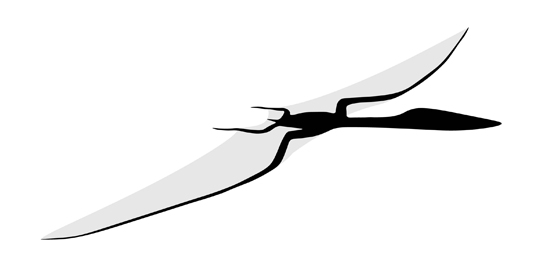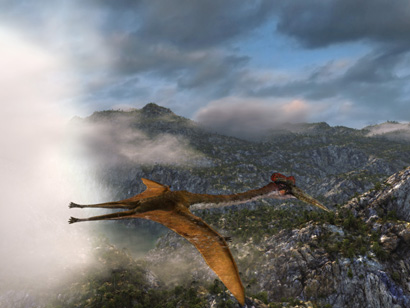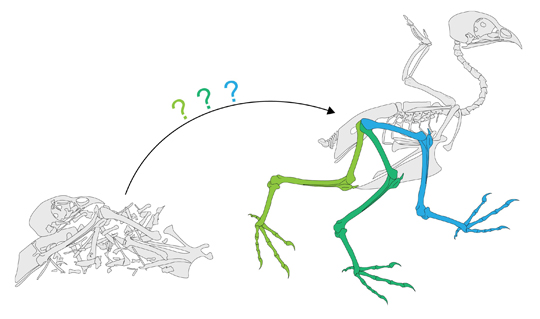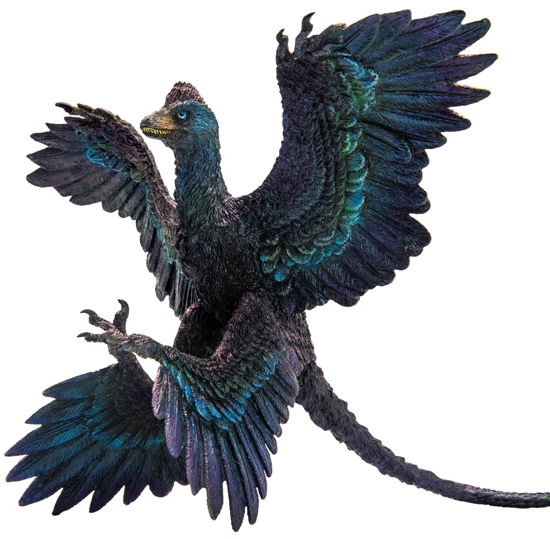Could We Have Got Pterosaurs All Wrong?
New Research Challenges Traditional View of Pterosaur Flight
Take a look at a picture of a pterosaur flying and you will see that most illustrations and life-reconstructions of these reptiles depict them travelling through the air with their hind limbs trailing behind them and their back legs wide apart. However, a new study undertaken by scientists from Brown University (Rhode Island) and the University of California (Berkeley), suggests that we have got this all wrong, pterosaur joints did not permit them to fly with their hind limbs splayed far apart.
Pterosaurs in the Air – But Have we got Their Hind Limbs in the Wrong Position?

Picture credit: John Conway
We Look at the Bones, But What About the Ligaments?
Flying with the hind limbs splayed out, is a posture adopted by most bats when they take to the air. Ever since the first flying reptiles were described and illustrated, these archosaurs have been depicted in the same way. However, this new research, published in the Proceedings of the Royal Society B (biology), suggests that ligaments would restrict joint movement and pterosaurs and the volant dinosaurs such as Microraptor, could not have flown in the same way as bats.
Lead author of this study, Armita Manafzadeh, a PhD student at Brown University commented:
“Most of the work that’s being done right now to understand pterosaur flight relies on the assumption that their hips could get into a bat-like pose. We think future studies should take into account that this pose was likely impossible, which might change our perspective when we consider the evolution of flight in pterosaurs and dinosaurs.”
The “Classical” Pterosaur Flying Posture
Picture credit: Armita Manafzadeh
The study undertaken in collaboration with Kevin Padian (University of California), attempted to infer the range of motion of joints in a way that takes into account the soft tissues such as ligaments surrounding the joint. Usually, soft tissue such as ligament and cartilage does not fossilise, so palaeontologists have to work out joint motion from just the bones alone. The pair of scientists set out to examine the joint movement of modern dinosaurs – birds, to test the extent to which ligaments influence joint motion.
Chickens at a Grocery Store
Student Manafzadeh explained that the idea started with grocery store chickens:
“If you pick up a raw chicken at the grocery store and move its joints, you’ll reach a point where you will hear a pop. That’s the ligaments snapping, but if I handed you a chicken skeleton without the ligaments, you might think that its joints could do all kinds of crazy things, So, the question is, if you were to dig up a fossil chicken, how would you think its joints could move and how wrong would you be?”
Quetzalcoatlus – A Giant Pterosaur Takes to the Air (Note the Splayed Out Back Legs)
Picture credit: Everything Dinosaur
Dead Quails and X-ray Images
Chickens may be easy to acquire, but for this scientific study, dead quails were used in order to assess joint mobility in a three-dimensional way, rather than just referring to the bones. Birds are the closest living relatives to the extinct pterosaurs and the non-avian dinosaurs. Birds (Aves), the Pterosauria and the Dinosauria are members of the Archosauria clade. This clade is usually divided into two distinct branches, on one branch (Crurotarsi), are the crocodilians and their ancestors plus several other extinct lineages such as the phytosaurs. The second branch (Avemetatarsalia) groups all the reptiles more closely related to birds than crocodilians.
A sub-group of the Avemetatarsalia is the Ornithodira, which specifically nests the Pterosauria and their ancestors and the Dinosauria and their ancestors, plus the descendants of dinosaurs – birds, together. Hence, the use of quail limbs to assess the range of movement and joint mobility.
The skin and muscle surrounding the joints was cut away and once the hip joints were exposed, the scientists manipulated them taking X-ray images to assess the likely range of motion. By doing this, they could determine the exact positions of the bones in poses where the ligaments restricted and then prevented further joint movement.
Mapping Out the Joint Movements of Ornithodirans
This technique enabled Manafzadeh to map out the range of motion of the quail hip with ligaments attached. She then compared this range of motion to what was inferred when the bones were considered in isolation. For the bones-only poses, Manafzadeh used traditional criteria that palaeontologists often employ — stopping where the two bones hit each other and when the movement pulled the thigh bone out of its socket.
This experiment revealed that over 95 percent of the joint positions that seemed plausible with bones alone were actually impossible when the ligaments were attached.
Mapping Out the Range of Motion in Quail Hips
Picture credit: Armita Manafzadeh
The Implications for Pterosaurs and the Maniraptora
The team’s next move was to calculate how the range of motion in living birds might correlate to the range of motion expected for extinct pterosaurs and those members of the Maniraptora, such as Microraptor that are believed to have been able to fly. The assumption has long been that these creatures flew in a similar way to bats. That is partly because the wings of pterosaurs were made of skin and supported by an elongated fourth finger, which is superficially similar to the wings of bats. Bat wings are also connected to their hind limbs, which they splay out widely during flight.
Many palaeontologists, Manafzadeh says, assume pterosaurs and four-winged dinosaurs did the same. But this new study suggests that pose was impossible.
In quail, a bat-like hip pose seemed possible based on bones alone, but outward motion of the thigh bone was inhibited by one particular ligament, a ligament that’s present in a wide variety of birds and other reptiles related to the Pterosauria. Consequently, in the absence of extraordinary evidence to the contrary, this analysis casts doubt on the “bat-like” hip pose traditionally inferred for pterosaurs and basal maniraptorans and underscores the point that reconstructions of joint mobility based on manipulations of bones alone can be misleading.
To achieve a “bat-like” flying posture, the ligament would have to stretch 63 percent more than the quail ligament can, the implication is that we have been illustrating flying reptiles and flying dinosaurs all wrong.
A Model of a Volant Dinosaur (Microraptor)
The image (above) shows a beautiful Microraptor model from PNSO.
To view this range of prehistoric animal models and figures: PNSO Age of Dinosaurs Models.
In addition to challenging traditional views about flight in pterosaurs and early birds, the research also provides new ways of assessing joint mobility for any joint of any extinct species by looking at its living relatives.
The scientific paper: “ROM Mapping of Ligamentous Constraints on Avian Hip Mobility: Implications for Extinct Ornithodirans” by Armita R. Manafzadeh, Kevin Padian published in the Proceedings of the Royal Society B
Everything Dinosaur acknowledges the assistance of a press release from Brown University in the compilation of this article.
View the award-winning Everything Dinosaur website: Everything Dinosaur.





